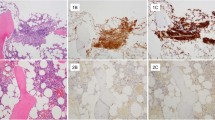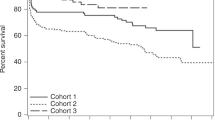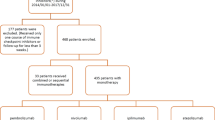Abstract
In our BMT Unit, we have observed a high frequency of skin rash associated with fever and other clinical findings during engraftment of autologous BM and/or PBSC. Thirty patients with breast cancer and 12 patients with Hodgkin’s or non-Hodgkin’s lymphoma, treated with the same regimen, were analyzed retrospectively or prospectively to characterize the clinical syndrome, its frequency, and its clinical course, as well as to define the factors affecting its incidence. In patients developing skin rash, the median and range for time to onset of skin rash and for time to increase in WBC after reinfusion of stem cells were identical (8 days, range 5–13) and did not differ significantly (P = 0.533). Twenty-three patients (55%) had skin rash, 18 patients had fever. Other, less frequent manifestations include platelet transfusion refractoriness (PTR), diarrhea, diffuse alveolar hemorrhage, and autoimmune thrombocytopenia or hemolytic anemia. A higher proportion of breast cancer patients developed the syndrome in comparison to lymphoma patients (67% vs 25%, P = 0.051). Acute GVHD grade I–II was established histologically in six patients with the syndrome. Comparison of the incidence of the syndrome by different variables using Fisher’s exact test revealed significance for disease category (P = 0.02) and number of previous treatment regimens (P = 0.002) as predictive factors for developing the autoaggression syndrome. In other words, patients with breast cancer and those with only one previous treatment regimen were more likely to develop the syndrome. This study suggests that an autoaggression GVHD-like syndrome accompanies the early phase of autologous engraftment and that a higher frequency of the syndrome might be seen in breast cancer patients undergoing high-dose chemotherapy and autologous stem cell transplantation.
This is a preview of subscription content, access via your institution
Access options
Subscribe to this journal
Receive 12 print issues and online access
$259.00 per year
only $21.58 per issue
Buy this article
- Purchase on Springer Link
- Instant access to full article PDF
Prices may be subject to local taxes which are calculated during checkout
Similar content being viewed by others
Author information
Authors and Affiliations
Rights and permissions
About this article
Cite this article
Moreb, J., Kubilis, P., Mullins, D. et al. Increased frequency of autoaggression syndrome associated with autologous stem cell transplantation in breast cancer patients. Bone Marrow Transplant 19, 101–106 (1997). https://doi.org/10.1038/sj.bmt.1700615
Received:
Accepted:
Issue Date:
DOI: https://doi.org/10.1038/sj.bmt.1700615
Keywords
This article is cited by
-
Dermatologic Conditions of the Early Post-Transplant Period in Hematopoietic Stem Cell Transplant Recipients
American Journal of Clinical Dermatology (2019)
-
Engraftment Syndrome: Clinical Features and Predictive Factors in Autologous Stem Cell Transplant
Indian Journal of Hematology and Blood Transfusion (2018)
-
Evaluation and Treatment of Stem Cell Transplant-Related Dermatoses
Current Dermatology Reports (2016)
-
Engraftment syndrome: double-edged sword of hematopoietic cell transplants
Bone Marrow Transplantation (2015)
-
Engraftment syndrome after auto-SCT: analysis of diagnostic criteria and risk factors in a large series from a single center
Bone Marrow Transplantation (2010)



